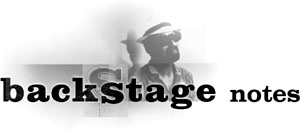 |
 |
|
|||||||||||||||||||||||||||||||||||||||||||||||||||||||||||||
 |
|||||||||||||||||||||||||||||||||||||||||||||||||||||||||||||||
| A
dream state: Sometime
in the mid-’80s I happened to catch sight of a Louisiana license plate
with the catch-phrase "A Dream State." Now that’s an
evocative motto (way more so than the current "Sportsman’s Paradise").
Fifteen trips there in as many years have convinced me that there’s not
an ounce of hype in it.
Mention Louisiana to roots music junkies and the first thing they’ll think of is New Orleans, the birthplace of jazz and the source of all that great R&B and proto-rock’n’roll from the ’50s and ’60s. It’s also the home of the New Orleans Jazz & Heritage Festival, the over-sized event that annually showcases a staggering amount of quality musical talent each spring. Travel outside the Crescent City, though, and you’ll find pockets of incredible music throughout the state. There were enough of them to inspire filmmaker Bob Mugge (profiled in BA #38) to poke around and create his most recent film, Rhythm ’n’ Bayous, demonstrating the wild variety of music available in Louisiana. Mugge filmed country, Cajun, jazz, rockabilly, blues, religious and zydeco artists like Dale Hawkins, Claude King (who performs the excruciating "long version" of his hit "Wolverton Mountain"), Henry Gray, Warren Storm, Buddy Flett, the Hackberry Ramblers, Dale and Grace ("I’m Leavin’ It All Up to You-ooh-ooh"), Kermit Ruffins, Rosie Ledet and lots more. The kinds of traditions that flourish in Louisiana would likely never fly in, say, North Dakota, or virtually anywhere else that’s grounded in what passes for consensus reality in Y2K+1. But like all traditional cultures, Louisiana’s are showing signs of strain as the older torch-bearers pass on and young people become seduced by what they see in living color on TV and the Internet.
Southwest Louisiana has long been the breeding ground for that hybrid of Creole music and the blues known as Zydeco,. At my first JazzFest we attended a fais do-do headlined by Rockin’ Dopsie on the Riverboat President. Dopsie had irritated some zydeco fans by crowning himself "King of Zydeco" while Clifton Chenier, the man whom many believed that title should always belong to, lay on his deathbed. By 1994, Beau Jocque and Boozoo Chavis were holding a mock-serious competition for that crown at the Habibi Temple in Lake Charles, as documented in Mugge’s Kingdom of Zydeco. Now, with Boozoo’s recent passing, the originators are all gone. Still standing, however, is Stanley Dural Jr., aka Buckwheat Zydeco. Dural knows the ropes and feels that his primary purpose is to make sure everybody has a good time. While we weren’t able to send a movie crew to Buckwheat’s Thanksgiving bash at El Sid-O’s, we came awfully close with Joe Rosen’s photo essay shot that night. Slip Buckwheat’s new Down Home Live in your CD player, turn to page 32 and we promise you will get the spirit. We featured another of the area’s tradition keepers, Chris Thomas King of Baton Rouge, in our 1999 summer issue. Since then Chris, now 37, has gotten a big career boost from his appearance in a hit Hollywood movie, but he hasn’t let that alter his focus. He continues to bring non-traditional elements into his playing while still retaining an essential blues integrity. His latest CD (on his own 21st Century Blues label) is a paean to Tommy Johnson, the Delta bluesman he portrays in O Brother, Where Art Thou? Shannon Williford takes a look at where fortune leadeth Chris today. Digging history: While we focus on profiling what’s happening in contemporary blues, we’re always interested in stories that give some insight into the musicians who set the stage for what we hear today. We’re fortunate in this issue to have excerpts from one brand-new and one upcoming book that dig into blues and R&B’s storied past. James Segrest and Mark Hoffman’s Moanin’ at Midnight: The Life of Howlin’ Wolf promises to be a definitive work on this powerful performer when the final version is published next year. We present you with the projected opening chapter of the biography of Howlin’ Wolf, centered on Wolf’s childhood and how it formed the man and his music. David Freeland’s Ladies of Soul (University Press of Mississippi) presents portraits of Denise LaSalle, Carla Thomas, Bettye Lavette, Barbara Mason, Maxine Brown and Timi Yuro in addition to the late Ruby Johnson, whom we’ve chosen to feature in this issue. Missing in action: Our harmonica know-it-all, the infamous Dr. Harpo, has been reported missing while on an emergency mission to the Amazon jungle to rescue a tribe of pygmies famed for their skills on a rare form of nose organ. Then again, knowing the Doc, maybe he just got lost while surfing Amazon.com and put his nose out of joint. The message, scrawled on a banana leaf and delivered to us by a blue macaw tap-tap-tapping at our chamber door, wasn’t real clear. But it did say he’ll be back next issue. Enough from me. It’s time for you to dive into what we think is a very rich blues buffet. Bon appetit! — CW
|
|
|